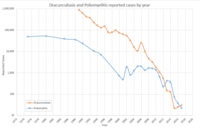List of diseases eliminated from the United States
This is a list of diseases known (or declared) to have been eliminated from the United States, either permanently or at one time. Most of the diseases listed were eliminated after coordinated public health campaigns. (Since some diseases can be eliminated and then reintroduced at a later time, such diseases are still eligible for the list, but with the fact of reintroduction noted.) Some entries are based on formal public health declarations, others are based on reliable information in the medical or public health literature. Since some diseases can be eliminated, but subsequently reimported without transmitting additional endemic cases, these are noted in a dedicated column. Although no fixed rule always applies, many infectious diseases (e.g., measles) are considered eliminated when no cases have been reported to public health authorities for at least 12 months.
(NB: In recent years, "elimination" is the preferred term for "regional eradication" of a disease; the term "eradication" is reserved for the reduction of an infectious disease's global prevalence to zero.)
The eliminated diseases
| Disease | Date last endemic case |
Date last imported case |
Notes | Reference(s) |
|---|---|---|---|---|
| Yellow fever | 1905 | 1996 | Last epidemic 1905, New Orleans; last imported case 1996 (prior to that 1924) | [1] |
| Smallpox | 1934 | 1949 | After widespread national vaccination efforts; routine vaccination of U.S. children discontinued in 1973; declared eradicated worldwide in 1980. | [2] |
| Babesia bovis babesiosis | 1943 | Cattle disease; occasionally infects humans. | ||
| Malaria | 1951 | 2016 | See National Malaria Eradication Program | |
| Poliomyelitis | 1979 | After widespread national vaccination efforts; see Poliomyelitis eradication. | ||
| Measles | 2000 | 2019[3] | After widespread national vaccination efforts. | [4] |
| Rubella | 2004 | After widespread national vaccination efforts. | [5] | |
| Diphtheria | 2012 | After widespread national vaccination efforts. | [6] | |
Possible future eliminations
Various public health projects are going on, with a goal of eliminating diseases from the country. Several infectious diseases in the United States, not on the above list, are considered close to elimination (98-99% reductions): e.g., Haemophilus influenzae, mumps, rubella and congenital rubella. Other disease pathogens (e.g., those of anthrax, rabies and tetanus) have been almost entirely eliminated from humans in the US, but remain as hazards in the environment, so cannot accurately be described as eliminated. The stated goal of "eradication" of hookworm from the southeast US (1915-20) was not achieved, although the hookworm-infection rate of that region did drop by more than half.[7]
- In 1954, Congressional funds were first approved for a Cooperative State-Federal Brucellosis Eradication Program to eliminate the disease from the country. (Brucellosis is a problem mainly in livestock. In 1956, 124,000 affected herds were found by testing in the US. By 1992, the number had dropped to 700 herds and the number of affected, domestic herds has declined to single digits since then.)
- The CDC Division of TB Elimination has a goal of controlling tuberculosis and eliminating it from the United States by minimizing the likelihood of Mycobacterium tuberculosis transmission, which will prevent the occurrence of new cases.[8]
- The Oral Rabies Vaccine (ORV) Program has a goal of preventing the spread of raccoon variant rabies and eventually eliminating it from the United States.
- An effort has been made for several years to eliminate syphilis from the US.[9] The rate of infection decreased through the 1990s, and in 2000, it was the lowest since reporting began in 1941, leading the US Surgeon General to issue a plan to eliminate the disease from the country. It has been staging a comeback, however, increasing each year since 2001.
References
- McFarland, Joy M.; Baddour, Larry M.; Nelson, Jeffery E.; Elkins, Sandra K.; Craven, Robert B.; Cropp, Bruce C.; Chang, Gwong‐Jen; Grindstaff, Alan D.; Craig, Allen S. (1997-11-01). "Imported Yellow Fever in a United States Citizen". Clinical Infectious Diseases. 25 (5): 1143–1147. doi:10.1086/516111. ISSN 1058-4838. PMID 9402373.
- "Smallpox Fact Sheet: Smallpox Disease Overview". Centers for Disease Control and Prevention. Archived from the original on 2013-04-02.
- "Measles Cases and Outbreaks". www.cdc.gov. January 31, 2019. Retrieved 9 February 2019.
- CDC, “Measles — United States, 2011”, Morbidity and Mortality Weekly Report (MMWR), April 20, 2012 / 61(15);253-257.
- CDC, “Rubella in the U.S.”, Rubella in the U.S., March 31, 2016
- CDC, “Notifiable Diseases and Mortality Tables”, Morbidity and Mortality Weekly Report (MMWR), March 21, 2014 / 63(11);ND-142-ND-155.
- Bleakley, Hoyt, “Disease and Development: Evidence from Hookworm Eradication in the American South”, Q J Econ. 2007; 122(1): 73–117.
- "CDC TB Division Mission Statement and Activities". www.cdc.gov. Retrieved 19 November 2016.
- "2010 National STD Prevention Conference". Centers for Disease Control and Prevention. 2010. Retrieved May 9, 2010.
